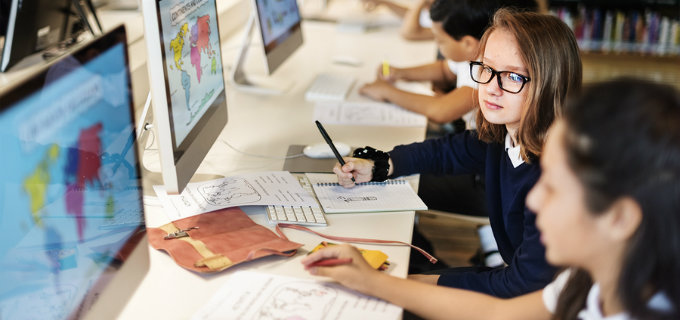Broaden Close Reading Beyond the Printed Page
By Jason D. DeHart

This third post in a series about what reading and literacy means in today’s world addresses the question: What does it mean to read closely when there are so many different ways for students to engage with text today?
Considering the Form
A little over a decade ago, there was a resurgence of focus on the act of close reading. I remember attending early morning trainings, meditating on the intentions of authors and reflecting on form critical approaches. The form critical approach focuses on the text itself and the moves of the author, lessening the personal response and opinion of the reader.
I appreciate this more arms-length method of literacy instruction while also noting that the role of the individual reader as meaning maker is still crucial. At the same time, I’m concerned with how often close reading seems to be an activity only focused on examples from authors like Mark Twain or Louisa May Alcott.
I contend that this purposeful work can apply to any text – with the question at heart of what the text is communicating and why the author/composer has made the set of choices that are evident in the finished product.
Defining Reading as a Network of Activities
It is important and necessary to help students navigate the complexities of the English language and to make connections across languages. For middle school students, it is also important to see reading as a network of activities, including digital and screen-based interactions.
Students can consider the choices that composers make to convey meaning, the use of particular words in prose or poetry, the juxtaposition of images and text in a video, the rhetorical moves of political candidates in campaign ads. Even the items arranged in a movie scene can be considered critically as each item – and even each framing of each item – is an intentional choice.

When it comes to the type of literacy I am thinking of, there is often a divide between the types of reading and writing activities that are part of state standards and instruction and the notion of digital literacy.
In the state standards that I am required to use, only a handful of standards hint at working across media, and those that do often frame this as a comparative approach, still linked to the traditional printed word.
While I have talked about comics, digital composing, and podcasts, this post is concerned with the robust nature of digital reading – close reading of the screen.
Close Reading for Media Awareness
Media literacy is yet another term in the wide-ranging family of literacy-attached terms. This branch of literacy has been written about extensively and well by authors like Renee Hobbs and Frank Baker, to name a few. Close, critical consideration of the digital image involves thinking about the way words are presented. These words can be spoken or written, and be used as a brief flash or a continued refrain.
And there is more. In addition to the spoken or printed words, the juxtaposition of these words with images and elements of design can work to provide a message of unity or discord.
Consider the video of a politician talking about all they have accomplished in their term. The spoken words are one aspect of meaning-making. What about the choice of music? The filter on the camera? The positioning of the figure? The camera angles? The kind of shots – wide and welcoming, or close and tense? The presence of other elements? Color schemes? Title cards?
The same message can be woven to support or oppose a position through overt or subtle means, and while close reading of media does involve the use of words it also involves a focus on visual rhetoric and design, as well as sonic literacy (another literacy term to explore!).
This idea of meaning making opens up the possibilities of engaging students in “what if” composition and remixing, beginning with questions like: What if the music was changed to a more somber tone or a more enthusiastic tone? What if the image of the screen changed? What if the camera was further away or closer, beneath or below the image of the screen? These prompts need not involve complicated media terminology, but can still invite conversation about the pathos-infused choices that are often made when composing texts.
When considering digital spaces, readers/viewers can focus attention on the presentation of words, the images used, and design choices, and can even explore the underpinnings of the message. This type of deeper analysis takes the work of close reading – including ideas about author, audience, and message – and broadens it to include communication methods from visual to verbal to auditory.
Who is responsible for this message? Is this an individual or organization? What is the goal of this organization? Are they trustworthy? What are their potential biases and agendas? There is much to unpack and uncover. A simple table to organize these questions and “noticings” can help students engage strategically.
The Connected World(s) of Text
Rather than list and describe every possible type of literacy or catalog each use of the term, my focus as a classroom teacher is to think about how to pare this idea down to its most universal and overarching kernel of truth. In short – what do my students need to know about literacy, and how can they make their stories known and voices heard?
First, literacy is powerful. My students, regardless of their path in life, deserve to have opportunities for creating and considering meaning. They have voices, and they should have access to the tools to share their voices and ideas – and to hear the voices and ideas of the community.
Literacy should not be limited. In other words, literacy engagement and activity does not stop with the printed page, the digital page, or a certain type of web space. Literacy occurs within and across all of these spaces because, ultimately, this is about the reader and their close, critical thinking. Literacy happens in the mind but is facilitated by the presence of text.
Limitless literacy leads to empathy. Classrooms where these skills are practiced are not only rich with texts but host a wide range of types of texts, from traditional to digital to hyperlinked to hybrid. More and more, all students can see themselves as readers and writers; moreover, students can practice and develop their identity as critical thinkers as they work on developing these skills in their middle and later years of education in order to become thoughtful and empathetic citizens.
It is on this note of empathy I will conclude this post. Renee Hobbs has noted that media and propaganda do have the potential for negativity – but also positivity. As young people consider how they will practice agency and advocacy to make positive change in the world, they can draw upon the resources of a range of tools and methods for sharing ideas with a global audience.
Close reading is vital preparation for this monumental work, and the space for that reading practice can be print, digital, visual, or verbal – or some combination of these.
Dr. Jason D. DeHart teaches English at Wilkes Central High School in Wilkesboro, North Carolina. He taught English Language Arts to middle grades students in Cleveland, Tennessee for eight years, earned his doctorate, and served as an assistant professor of reading education at Appalachian State University before returning to his first love, the secondary classroom.
Jason’s work has appeared in Edutopia, SIGNAL Journal, English Journal, The Social Studies, and the NCTE Blog. See all of Jason’s MiddleWeb posts here – including a 3-part series with teacher and school librarian Jennifer Sniadecki on using picture books with middle level readers. His website Book Love: Dr. J. Reads offers book reviews and author interviews.






































While Dr. DeHart doesn’t mention how his media literacy instruction in the classroom aligns with the school librarian’s instruction, a new 2024 ebook does explain the school librarian’s media literacy goals. Together this blog entry and the ebook make a strong case for two educators working together for powerful student learning around “close reading” in the broadest sense. See chapter 2 of this free ebook:
https://read.bookcreator.com/ynKAZqWPLuUm0EUFY8ZOqJckt7o2/j1VjNJGXSeS08BzQMP0jYQ/FfmkEby3TGCxLXWRcChX6A-right